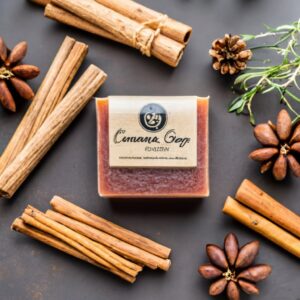
Discover the art of crafting a delightful cinnamon-infused soap with our step-by-step guide! These handmade cinnamon soap bars are perfect for spreading joy during the holiday season by gifting them to your loved ones. Explore various cinnamon essential oils and gain insights into the safe incorporation of cinnamon into skincare formulations.
DIY cinnamon soap
Indulge in the delight of creating your own natural cinnamon soap with this irresistible recipe! This skincare project is not only enjoyable and straightforward but also yields a soap with a captivating cinnamon fragrance and a stunning marble appearance. Using a melt and pour base, this soap is enriched with the essence of cinnamon powder and essential oils.
For the festive season, I take pleasure in sharing beauty gifts, and this cinnamon bar soap stands out as one of my top recommendations. If you’re looking for more homemade Christmas soap ideas, consider exploring recipes like layered candy cane soap, pumpkin spice soap, moisturizing winter soap, cranberry soap, and my personally crafted DIY pine soap. Elevate your holiday gifting with these delightful and aromatic creations!
Cinnamon soap benefits
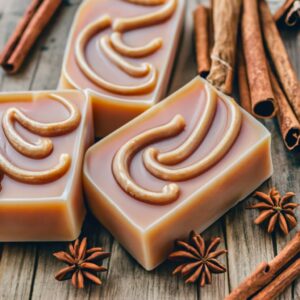
Cinnamon soap offers a range of potential benefits, thanks to the natural properties of cinnamon and its impact on the skin. Here are some potential benefits of using cinnamon soap:
- Antibacterial Properties: Cinnamon has natural antibacterial properties, which may help in fighting bacteria on the skin. This can be beneficial for preventing and treating acne or other skin infections.
- Anti-Inflammatory Effects: Cinnamon contains anti-inflammatory compounds that may help soothe irritated skin and reduce inflammation. This can be particularly useful for individuals with sensitive or inflamed skin conditions.
- Exfoliation: Cinnamon has a slightly coarse texture, and when used in soap, it can act as a gentle exfoliant. This can help remove dead skin cells, promoting smoother and brighter skin.
- Improved Blood Circulation: The warming properties of cinnamon may help stimulate blood circulation when applied to the skin. Improved blood flow can contribute to a healthier complexion.
- Aromatherapy: The aromatic scent of cinnamon is known to have mood-enhancing properties. Using cinnamon soap can provide a pleasant and invigorating sensory experience during your skincare routine.
- Antioxidant Content: Cinnamon contains antioxidants that may help protect the skin from environmental damage caused by free radicals. This can contribute to maintaining a youthful and healthy complexion.
- Enhanced Skin Tone: Regular use of cinnamon soap may contribute to an improved skin tone, helping to even out pigmentation and reduce the appearance of dark spots.
Ingredients
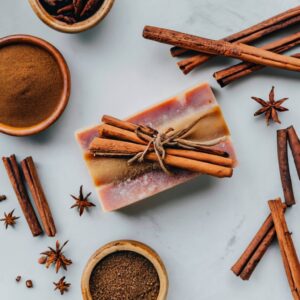
Creating your own cinnamon hand soap is a breeze with this straightforward shopping list of just 5 essential ingredients, with 2 optional additions. Let’s dive into the materials you’ll need:
- Soap Base: Opt for a melt-and-pour soap that can be easily melted and customized to your liking. Any type of melt and pour soap works, but for a soap resembling mine, consider using a white soap base such as goat’s milk or shea butter.
- Ground Cinnamon: This powder, derived from dried cinnamon bark, not only imparts a natural fragrance and color but also provides a gentle exfoliating effect. Further details about incorporating cinnamon powder into the soap are discussed below.
- Jojoba Oil (Optional): An excellent moisturizer, jojoba oil is a great addition for caring for dry and chapped hands.
- High-Proof Alcohol (Optional): Opt for rubbing alcohol or Everclear to achieve a marble effect. The alcohol evaporates during the mixing process and won’t be present in the final soap. If you prefer, you can swirl the ground cinnamon directly into the soap base without using high-proof alcohol.
- Essential Oils: These not only add a delightful natural fragrance but also bring additional skincare benefits. In the next section, you’ll find six different essential oil blends to choose from. Note that cinnamon essential oil can be irritating, so be sure to read the safety tips provided below.
Tools
These tools will facilitate a seamless soap-making experience, allowing you to create beautiful and aromatic natural cinnamon soap bars.
- Cutting Board and Paring Knife: For chopping the melt and pour base with precision.
- Large Glass Measuring Cup: Ideal for melting the soap base, providing a convenient and heat-resistant container.
- Silicone Mold: Choose a mold that suits your preference; a round soap mold works well for creating individual soap bars.
- Spray Bottle with High-Proof Alcohol (Optional): This optional tool can be used to disperse bubbles during the soap-making process, ensuring a smoother finish.
Essential oils for cinnamon soap
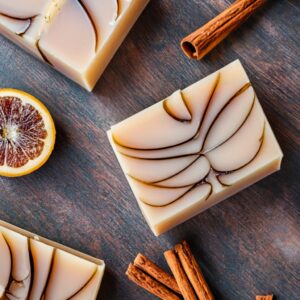
I couldn’t agree more! Crafting unique essential oil blends is a delightful aspect of home soap making, and the rich fragrance of cinnamon offers a wonderful palette to experiment with. Here are some delightful cinnamon-inspired combinations to infuse your soap with aromatic goodness:
(Note: The quantities listed are designed for 1 lb / 450 g of soap, yielding approximately 4 soap bars.)
| Base Essential Oil | Complementary Oils | Notes |
|---|---|---|
| Cinnamon | Sweet Orange | Warm and Citrusy |
| Lavender | Peppermint | Floral with a Minty Twist |
| Eucalyptus | Tea Tree | Fresh and Cleansing |
| Lemon | Rosemary | Bright and Herbal |
| Grapefruit | Ylang-Ylang | Fruity and Floral |
| Bergamot | Patchouli | Citrus with Earthy Undertones |
Cinnamon and skin safety
Indeed, while cinnamon essential oil carries potential benefits, it is also considered a controversial skincare ingredient due to its propensity to cause severe skin irritation, redness, rashes, and a burning sensation.
To minimize the risk of adverse effects, it’s essential to adhere to these safety tips:
- Choose Cinnamon Leaf Essential Oil: Opt for cinnamon leaf essential oil rather than cinnamon bark or cassia, as the latter two are not considered safe for skincare.
- Avoid Undiluted Application: Never apply the oil directly to the skin without dilution. Always mix it with a suitable carrier oil before use.
- Limit Concentration in Recipes: Do not exceed 0.5% of cinnamon essential oil in your cinnamon soap recipe. This translates to approximately 40 drops, 2 grams, or 0.07 ounces of essential oil per pound of soap.
- Conduct a Patch Test: If you’re new to using cinnamon essential oil, perform a small patch test. Dilute 1 drop of the essential oil in 1 teaspoon of carrier oil and apply it to a small area on your arm or elbow. Wait for 24 hours to observe any adverse reactions. If no reaction occurs, you can safely incorporate the oil into your skincare routine.
How to make cinnamon soap

Making soap can indeed seem daunting for beginners, but fear not! This cinnamon melt and pour soap recipe is straightforward, and you’ll be delighted with the results if you follow the steps closely. Trust the process, and you’ll have beautiful cinnamon soap bars in no time!
Step 1: Dilute Cinnamon Powder (Optional)
- Combine ground cinnamon and 1 to 2 tbsp high-proof alcohol in a small glass jar.
- Stir until the cinnamon is thoroughly dispersed in the alcohol.
- This step is optional but helps distribute the cinnamon evenly. Alternatively, you can stir the powder directly into the soap base for a rustic effect.
Step 2: Melt Soap Base
- Divide the soap base into small cubes.
- Place the cubes in a microwave-safe container or glass measuring cup.
- Melt in 30-second intervals, stirring between each burst to avoid burning.
Step 3: Add Jojoba Oil and Essential Oils
- Introduce jojoba oil and essential oils to the melted soap.
- Mix thoroughly until the oils are well incorporated.
Step 4: Divide Soap
- To achieve a marbling effect, pour half of the soap mixture into another measuring cup.
Step 5: Cool Soap
- Allow the soap to cool and thicken slightly. Pouring hot soap may cause cinnamon bleeding into the white soap, resulting in a uniform brown color.
Step 6: Stir in Cinnamon Slurry
- Add the cinnamon slurry to one portion of the soap and stir to combine.
Step 6: Pour Soap
- Simultaneously pour both soap mixtures into the mold.
- Optionally, spritz the top with alcohol to dissolve any bubbles. Decorate with a sprinkle of cinnamon.
Step 7: Let Solidify
- Let the soap bars cool and harden in the mold.
- Choose between room temperature (1 to 2 hours) or refrigeration (30 minutes) for the cooling process.
Step 8: Unmold
- Once solidified, gently pull back the mold to break the airlock.
- Pop each soap bar out of the mold.
Step 9: Package and Store
- Wrap the cinnamon soap bars tightly in plastic wrap to protect them from moisture.
- Enjoy your homemade cinnamon soap!
Variations for Variation
| Variation | Procedure |
|---|---|
| Cinnamon Honey Soap | Dissolve 1 tsp unpasteurized honey in the warm soap base. |
| Cinnamon Coffee Soap | Sprinkle 1 tbsp coffee grounds into the soap. Let cool slightly before pouring into the mold. |
| Turmeric Cinnamon Soap | Prepare the soap recipe with 1/2 tsp cinnamon powder and 1/2 tsp ground turmeric. |
| Oatmeal Cinnamon Soap | Mix 1/4 cup / 45 g / 1.6 oz rolled oats into the soap. Stir until the soap has slightly thickened before pouring into your mold. |
Packaging, Gifting, Storage, and Shelf Life:
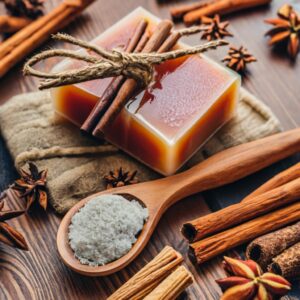
- Packaging:
- Wrap bars tightly in plastic wrap to prevent moisture absorption.
- Gifting:
- Download free printable soap labels for a personalized touch.
- Storage:
- Store at room temperature in a dark place, away from direct sunlight.
- Shelf Life:
- Expect a shelf life of 1 to 1.5 years for cinnamon hand soap.
Tips for using cinnamon soap

- Patch Test: Before using cinnamon soap extensively, perform a patch test. Apply a small amount of the soap to a small area of your skin and observe for any adverse reactions. If irritation occurs, discontinue use.
- Gentle Application: Cinnamon soap can be potent, so avoid vigorous rubbing. Gently apply the soap to your skin and allow it to work without excessive scrubbing.
- Avoid Sensitive Areas: Be cautious around sensitive areas of the skin, such as the face and genitals. Cinnamon may cause irritation in these areas.
- Rinse Thoroughly: After applying cinnamon soap, ensure you rinse thoroughly with water to remove any residue.
- Moisturize: Cinnamon can have a drying effect on the skin. Follow up with a moisturizer after using cinnamon soap to keep your skin hydrated.
- Limit Frequency: Use cinnamon soap in moderation. Excessive use may lead to skin irritation.
- Store Properly: Keep your cinnamon soap in a cool, dry place to maintain its quality and prevent moisture absorption.
- Use in Warm Water: When using cinnamon soap, opt for warm water instead of hot water. Hot water can strip away natural oils and exacerbate dryness.
- Keep Away from Eyes: Avoid contact with the eyes. If soap comes into contact with the eyes, rinse thoroughly with water.
- Monitor Skin Reaction: Pay attention to how your skin reacts over time. If you notice persistent irritation, consult a dermatologist.
faq’s
What is cinnamon soap good for?
Cinnamon soap is known for its potential antibacterial properties, anti-inflammatory effects, and exfoliating qualities. It may help fight bacteria, soothe irritated skin, and promote a healthier complexion. The aromatic properties of cinnamon can also add a pleasant fragrance to the soap.
Can I put ground cinnamon in my soap?
Yes, you can incorporate ground cinnamon into soap recipes. It not only adds a natural fragrance but can also provide a gentle exfoliating effect. It’s essential to consider safety guidelines and ensure proper dilution to avoid skin irritation.
Can I add cinnamon to my bathing soap?
Yes, you can add cinnamon to your bathing soap. However, it’s crucial to be mindful of the concentration and follow safety guidelines to prevent skin irritation. Incorporating cinnamon can offer potential skincare benefits and a pleasant scent to your bathing experience.
How do you make cinnamon liquid soap?
To make cinnamon liquid soap, you can start with a liquid soap base and add diluted cinnamon essential oil or a cinnamon-infused liquid. Dilute the essential oil to avoid skin irritation, and mix it thoroughly into the liquid soap base. Ensure proper blending to achieve a consistent and well-distributed cinnamon scent.
Is cinnamon OK to put on the skin?
Cinnamon can be safe for the skin when used appropriately and in moderation. However, it is essential to follow safety guidelines, such as diluting cinnamon essential oil and conducting patch tests, to prevent skin irritation. Individuals with sensitive skin should be cautious when using cinnamon on the skin.
Is cinnamon safe on the skin?
Cinnamon can be safe on the skin when used in a properly diluted form. Cinnamon essential oil, particularly from cinnamon leaf rather than bark or cassia, is commonly considered safe for skincare. However, individual skin reactions vary, and it’s advisable to perform patch tests before widespread use.
What are the side effects of cinnamon for the skin?
Potential side effects of cinnamon for the skin include skin irritation, redness, rashes, and a burning sensation, especially when used in high concentrations or in an undiluted form. Following safety guidelines, choosing the right type of cinnamon, and proper dilution can minimize these risks.
Why is my skin burning after applying cinnamon?
A burning sensation after applying cinnamon on the skin could be due to its natural warming properties. However, if the burning is excessive or accompanied by irritation, it may indicate sensitivity or an allergic reaction. In such cases, it’s recommended to wash the affected area, discontinue use, and consult a healthcare professional if necessary.
